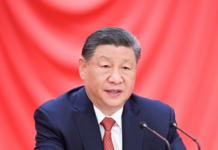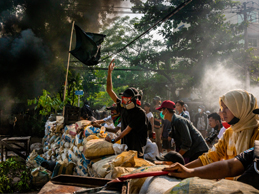Two years have passed since Myanmar’s National Unity Government (NUG), a government in exile, had launched (September 7) a “defensive war” and nation-wide revolution against the military rule. In contrast to Myanmar’s historically uncontested military power, the military today faces widespread and vehement opposition from ethnic armed organizations, people’s defence forces, and citizens who have organized militias.
The PDFs and EAOs have advanced significantly over the last two years, while being in asymmetrical conflict with the army of the Junta, a considerably more technologically and militarily sophisticated adversary. All 14 states but Rakhine State are experiencing active conflicts. Since the outset of the coup, Sagaing has been the stronghold of the resistance. The government forces here suffered the most losses. Combat became more intense in the Shan, Kachin, Kayah, Chin, and Mon states.
Among the four EAOs, the Kachin Independence Army (KIA), the Karen National Union (KNU), the Karenni National Progressive Party (KNPP), the Chin National Front (CNF), and the ‘All Burma Students Democratic Front (ABSDF)’ have openly allied with pro-democracy forces.
The second group known as the ‘Three Brotherhood Alliance’, consist of the Arakan Army (AA), Ta’ang National Liberation Army (TNLA) and Myanmar National Democratic Alliance Army (MNDAA). AA has engaged in fighting with the regime, now has a ceasefire. The other two provide military training and weapons to resistance forces.
The third group consists of the United Wa State Army (UWSA), the Shan State Progress Party (SSPP)/Shan State Army-North, and the National Democratic Alliance Army (NDAA, or Mongla Group) are currently observing ceasefires with the Myanmar military.
The fourth group consists of seven EAOs: the RCSS, the New Mon State Party (NMSP), the Democratic Karen Benevolent Army (DKBA), the Karen National Union/Karen National Liberation Army-Peace Council (KNU/KNLA-PC), the Arakan Liberation Party (ALP), the Pa-O National Liberation Organization (PNLO), and the Lahu Democratic Union- all are NCA signatories and currently engaged in peace talks with the regime.
According to an assessment by ‘The Irrawaddy’, there are approximately 150,000 EAO troops. Among them about 31 percent of EAOs are actively participating in the ongoing revolution against the dictatorship, while just 7 percent have sided with it. Therefore, the remaining 62 percent of EAO forces can be crucial to this revolution.
In its report released on September 7, to mark the second anniversary of the declaration of the people’s defensive war against the junta, the NUG’s Defense Ministry estimated that the junta’s ground combat force at the start of the war numbered about 65,000, comprising 521 combat battalions including 214 Light Infantry Battalions and 307 Infantry Battalions. The air force, navy and reserve forces of the junta had around 225,000 to 240,000 troops.
Global and regional actors need to step up to the plate to offer real support to Myanmar in its crises- help Rohingyas to be repatriated, promote a federal democratic system and oppose any calls for the state to be divided.
Over the past two years, around 9900 clashes took place and around 12.5 percent of the junta’s total strength was lost, as around 30,000 troops were killed in the clashes, the ministry said. It also said that 28 junta bases including outposts, police stations, border guard outposts and pro-junta Pyu Saw Htee militia camps were seized in the first year of the war of resistance and another 107 enemy camps were seized in the second year of the armed revolution.
The NUG has formed 293 PDF battalions and 250 Township Defense Groups, to wage war against regime troops across the country. Twenty-two ethnic defence groups are fighting the junta alongside the PDFs and EAOs, the ministry added.
The junta has lost control in most of the rural areas of the country and urban resistance attacks targeting regime forces, junta bases and regime-run government department offices are often reported in towns and cities. The NUG’s Defense Ministry says its armed forces had conducted urban attacks in more than 100 towns and cities.
The junta is struggling to defeat the resistance, focusing on multiple front lines across the country. Human resource shortage and defection from rank and files are making regimes struggle tougher.
Air power has been the regime’s crucial weapon to slow down the advances of resistance forces. Although, the junta received 2 Su-30 fighter jets from Russia recently, Indian Defense Research Wing reported on September 1 that the Myanmar Air Force had grounded all its 11 JF-17 Thunder fighters because of technical reasons. This has been a blow to the regime’s air power. The grounding of the whole squadron has significantly disrupted Nay Pyi Taw’s plan for targeted airstrikes against PDF and EAO positions.
The junta has forced to change its tactics in August 2023 from offensive to defensive in several resistance strongholds amid an increase in attacks in ethnic areas and other resistance strongholds. Even its capital it now under threat.
In August, the junta deployed massive numbers of troops in Kachin, Shan and Kayah states to regain territory lost to EAOs and resistance forces. At the same time, it had to repel escalating attacks in Chin and Mon states.
The military junta has lost control of almost all of Sagaing Region and many townships in Magwe and Mandalay regions. Most roads in Sagaing and Magwe regions are now controlled by resistance groups, while junta assets —police stations, military bases, checkpoints and township general administration department offices —are being hit by drone strikes, raids and shelling daily. The junta reportedly lost control of more territory in some townships in Tanintharyi Region, eastern Bago, Kayah, Kachin, Northern Shan and Chin States.
However, Junta atrocities continue. Rights group Assistance Association for Political Prisoners (AAPP) says, at least 4,071 civilians have been killed and more than 24,700 individuals detained by the junta forces since the February 2021 coup. ‘Data for Myanmar’, a local monitoring group says that, as of July 31, the junta troops and its affiliated militia groups had burned down about 74,850 civilian homes countrywide.
In another report, NUG says, the regime has committed at least 144 massacres since 2021 including 48 between January and July this year and killed 1,595 civilians countrywide. This caused nearly 1.9 million internally displaced persons in Myanmar, says the UN Office for the Coordination of Humanitarian Affairs.
Under the direction of Sr. Gen. Min Aung Hlaing, junta security forces have committed crimes against humanity against protesters, journalists, lawyers, medical personnel, and members of the political opposition by engaging in mass executions, torturing, sexual assault, arbitrary arrests, and other abuses. The nature of the security force crackdown– methodical, widespread, and systematic– reflects the junta’s policy of suppressing the opposition.
“Is Myanmar’s military starting to lose the war?” was the title of a study in The Asia Times. Anthony Davis, a military and security specialist, stated that despite his initial belief that the situation would be hopeless immediately following the coup, he now believes that the resistance movement is consolidating successes.
However, opinions on the situation in Myanmar can vary greatly. For instance, The Economist recently stated in an article titled, “Myanmar’s resistance is at risk of believing its own propaganda,” that the “narrative of imminent victory” for the resistance movement is being promoted via Myanmar’s social media platforms, but the facts on the ground speak a different language.
“Peer past the virtual fog, and a far bleaker picture emerges … Armed anti-regime groups are fragmented, with up to a dozen in a single district. A paucity of weapons has left them unable to go beyond guerrilla ambushes and assassinations,” it reads.
The majority of publications on the fighting in Myanmar expressly mention issues with faulty data. According to Davis, “coherent analysis is complicated by the sheer frequency and spread of small-unit clashes and attacks across a vast swath of the country, and by a striking lack of impartial news reporting from the frontlines of a civil war largely shielded from the outside world.”
Local journalist Cape Diamond said that the media in Myanmar do not “deliver the entire picture” and often “understate defeats” of the PDFs.
However, the overall performance of the resistance movement in the past two years has been largely successful due to the support of the people. The main challenge is acquiring weapons and establishing a central command system to fight unitedly and strategically to achieve greater success in the armed resistance movement. A clear and precise plan on ousting the current military regime is somehow very important.
Unlike the rush by Western governments to support and fund Ukraine and President Volodymyr Zelensky in the wake of the Russian invasion, the Myanmar opposition is receiving little or nothing at all. Un-willingness to support the NUG in terms of weapons and funding means the Myanmar crisis could drag on for years, despite the “feel-good” statements of the NUG saying 2023 should be the last year for the Spring Revolution to roll out before victory.
Global and regional actors need to step up to the plate to offer real support to Myanmar in its crises- help Rohingyas to be repatriated, promote a federal democratic system and oppose any calls for the state to be divided.























